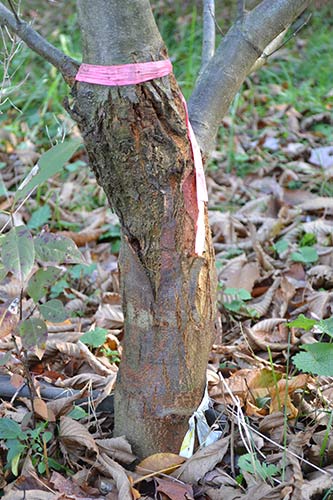
In 1904, a forester at the Bronx Zoo in New York discovered a fungus that would eventually spell disaster for eastern forests. Endothia parasitica, later known as Cryphonectria parasitica (or chestnut blight) is believed to have been introduced to America by imported Asian chestnut trees. This disease spread quickly down the East Coast, affecting American chestnut trees throughout the Appalachian Mountain range. In the Blue Ridge Mountains, where chestnut trees once accounted for a quarter of the tree canopy, the blight has devastated the tree population.
For those living amongst the southern Appalachians, American chestnut trees were a valuable resource. The trees boasted lightweight wood that was resistant to decay and, of course, the flavorful fruit that would fall in late autumn. The wood was ideal for building log homes, as well as items such as poles and posts. The fruits benefitted the forest animals as well as people, who would collect them for their own families or to sell in town. With the American chestnut accounting for such a large percentage of the timber industry and the culture of surrounding communities, the threat from chestnut blight was taken seriously.

But even with a government grant, scientists could not produce an effective strategy. Within 40 years the American chestnut population was wiped out. Many organizations have been focused on not only reintroducing this species into forests, but rebuilding in the areas that lost so many trees. Planting different types of trees in areas that have been affected by blight has been a popular strategy among organizations and volunteers that are trying to rebuild eastern forests after the devastation to the American chestnut trees. Here at American Forests, a recent Global ReLeaf project in Kentucky is working to do just that. Alongside the American Chestnut Foundation, Coal Country Beeworks and James River Coal, Inc., we will plant more than 7,500 seedlings of different species including flowering dogwood, persimmon, eastern redbud, red mulberry and yellow poplar in an area that used to be dominated by the American chestnut and also suffered as the former site of a mine.
Meanwhile, the American Chestnut Foundation is also working with the U.S. Forest Service to introduce a cross species in the Blue Ridge Mountains. The foundation has recognized that the chestnut root stocks are alive and growing, but the trees that will eventually grow are susceptible to blight and will inevitably die. They have also found that the Chinese chestnut tree is resistant to the disease and have been focused on creating a hybrid in order to reintroduce a new form of American chestnut. Scientists worked until they were able to develop a crossbreed that was 15/16 American chestnut and 1/16 Chinese chestnut. The U.S. Forest Service, American Chestnut Foundation and about 20 volunteers worked to plant almost 1,200 saplings in some of the more barren areas in some Western Virginia forests.
While our eastern hardwood forests may not resemble the forests of our ancestors, through these various restoration techniques and efforts, we hope to maintain a healthy, diverse forest for future generations.